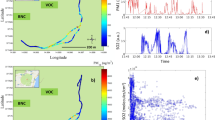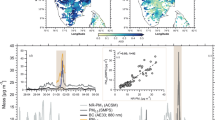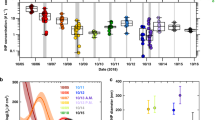Abstract
ACTIVE volcanoes have been suggested as being sources of atmospheric ice nuclei1,2, the rare yet crucial particles that initiate much of the Earth's precipitation. Other studies indicate that some volcanoes are not adding ice nuclei to the atmosphere or may be deactivating natural ice nuclei3–5. We report here measurements of atmospheric ice nucleus concentrations upwind and within the effluent plume of St Augustine, an actively venting island volcano situated at the base of the Aleutians in the mouth of Cook Inlet, Alaska (59°20′N, 153°30′W). St Augustine erupted violently on January 23, 1976 and then again on February 4, 1976. We find no evidence for ice nuclei production by this volcano. Between and after the major eruptions the volcano actively vented giving off gaseous and particulate matter. Sulphur dioxide concentrations in the plume were >5p.p.m. (J. Moyers, unpublished) and the total particulate loading was ∼100 μg m−3 (W. Zoller, unpublished) during the venting stages. A photograph of the venting volcano (February 1, 1976), taken as the National Center for Atmospheric Research (NCAR) Electra aircraft (instrument boom visible to left) prepared to enter the plume on a sampling run, is shown in Fig. 1. During this and other sampling runs ice nuclei in the air were captured on Millipore membrane filters using the NCAR SAMOVAR Air Filtration System6.
This is a preview of subscription content, access via your institution
Access options
Subscribe to this journal
Receive 51 print issues and online access
$199.00 per year
only $3.90 per issue
Buy this article
- Purchase on Springer Link
- Instant access to full article PDF
Prices may be subject to local taxes which are calculated during checkout
Similar content being viewed by others
References
Isono, K. M., Komobayashi, K., and Ono, A., Nature, 183, 317 (1959).
Hobbs, P. V., Fullerton, C. M., and Bluhm, G. C., Nature, 230, 90 (1971).
Price, S., and Pales, J. C., Mon. Weath. Rev., 92, 207 (1964).
Pueschel, R. F., and Mendonca, B. G., Tellus, 24, 139 (1972).
Fullerton, C. M., Garcia, C. J., and Langer, G., Met. Per. Rdsch., 28, 178 (1975).
Moore, H., NCAR Report (Boulder, Colorado, 1975).
Langer, G., and Rodgers, J., J. appl. Meteorol., 14, 560 (1975).
Mossop, S. C., and Thorndike, N. S. C., J. appl. Meteorol., 5, 474 (1966).
Pruppacher, H. R., Chemistry of the Lower Atmosphere, 1–66 (edit. by Rasool, S. I.) (Plenum, New York, 1973).
Radke, L. F., Hobbs, P. V., and Stith, J. L., Geophys. Res. Lett. 3, 93 (1976).
Hidy, G. M., Proc. 3rd. Conf. on. Environmental Toxicology, Rochester, New York, 43 (1970).
Author information
Authors and Affiliations
Rights and permissions
About this article
Cite this article
SCHNELL, R., DELANY, A. Airborne ice nuclei near an active volcano. Nature 264, 535–536 (1976). https://doi.org/10.1038/264535a0
Received:
Accepted:
Published:
Issue Date:
DOI: https://doi.org/10.1038/264535a0
Comments
By submitting a comment you agree to abide by our Terms and Community Guidelines. If you find something abusive or that does not comply with our terms or guidelines please flag it as inappropriate.



